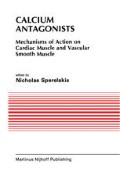Abstract
One of the steps in the chain of events that briners about the contraction in frog twitch muscle cells is the release of calcium from the terminal cisternae. In his 1952 review, Sandow (1) proposed that an influx of Ca ions into twitch muscle cells during an action potential might initiate the contraction. A net calcium influx observed with flux measurements during contraction by Bianchi and Schanes in 1959 (2) and by Curtis in 1966 (3) supported Sandow’s proposition. However, Armstrong, Bezanilla and Horowicz (4) showed in 1972 that when external calcium is lowered with EGT A to 10-8 M, isolated frog muscle fibers can produce normal twitches for many minutes. In 1979 Lűttgau (5) obtained similar results with tetani. Nevertheless, Stanfield in 1977 (6) and Sanchez and Stefani in 1978 (7) found that Dhasic skeletal muscles have an inward calcium current (lCa) which could be the basis of calcium spikes previously described by Beaty and Stefani in 1976 (8). Under certain conditions Barrett and Barrett (9) found that a reduction of external calcium with 80–90 mM EGTA brings about a reversible blockade of contraction leading some of the above mentioned authors (7,9) to suggest that extracellular calcium moving into the cell due to ICa may be involved in excitation-contraction (e-c) coupling. This proposition was further supported by the localization of ICa in the T-system found by Nicola Siri, Sanchez and Stefani (10). This finding circumvented the problem of the delay due to calcium diffusion from the surface membrane into the center of the fiber. Since calcium entry may play a role in e-c coupling, the present experiments were designed to analyze some of the effects that diltiazem has on the ICa and that blocking the ICa with this drug has on initiating and sustaining contractions in frog twitch muscle fibers.
Access this chapter
Tax calculation will be finalised at checkout
Purchases are for personal use only
Preview
Unable to display preview. Download preview PDF.
References
Sandow, A. Excitation-contraction coupling in muscular response. Yale J. Biol. Med. (25): 176–201, 1952.
Bianchi, C. P. and Shanes, A. M. Calcium influx in skeletal muscle at rest, during activity, and during potassium contracture. J. Gen Physiol. (42): 803–815, 1959.
Curtis, B. A. Ca fluxes in single twitch muscle fibers. J. Gen Physiol. (50): 255–267, 1966.
Armstrong, C. M., Bezanilla, F. M. and Horowicz, P. Twitches in the presence of ethylene glycol bis(β-aminoethyl ether)-N,N’-tetraacetic acid. Biochim. Biophys. Apta 267: 605–608, 1972.
Luttgau, H. and Spiecker, W. The effects of calcium deprivation upon mechanical and electrophysiological parameters in skeletal muscle fibers of the frog. J. Physiol. (296): 411–429, 1979.
Stanfield, f. R. A calcium dependent inward current in frog skeletal muscle fibers. Pflűrers Arch. (368): 267–270, 1977.
Sanchez, J. A. and Stefani, E. Inward calcium current in twitch muscle fibres of the frog. J.Physiol. (283): 197–209, 1978.
Beaty, G. N. and Stefani, E. Calcium dependent electrical activity in twitch muscle fibres of the frog. Proc. R. Soc. B 194: 141–150, 1976.
Barrett, J. N. and Barrett, E. F. Excitation-contraction coupling in skeletal muscle: blockade by high extracellular concentrations of calcium buffers. Science, N.Y. (200):1270–1272, 1978.
Nicola Siri, L., Sanchez, J. A. and Stefani, E. Effect of glycerol treatment on the calcium current of frog skeletal muscle. J. Physiol. (305): 87–96, 1980.
Fleckenstein, A. Specific pharmacology of calcium in myocardium, cardiac pacemakers, and vascular smooth muscle. Ann. Rev. Pharmacol. Toxicol. (17): 149–166, 1977.
Lathrop, D. A., Valle, P., Guam, W. E., Schwartz, A. and Kaplan, S. The effect of diltiazem and nisoldioine on spontaneously active human atrial tissue. J. of Molec. and Cell Cardiol. (13): 111–115, 1981.
Gonzalez-Serratos, K., Valle-Aguilera, R. Lathrop, D. A. and Garcia, Maria del Carmen. Slow inward calcium currents have no obvious role in frog twitch muscle excitation-contraction coupling. Nature (298): 292–294, 1982.
Hille, B. and Campbell, D. T. An improved vaseline gap voltage clamp for skeletal muscle fibers. J. Gen Physiol. (67): 265–293, 1976.
Gonzalez, F., Lydia Hill and P. Valle-Aguilera. Effects of catecholamines and cyclic AMP on excitation-contraction coupling in isolated skeletal muscle fibres of the frog. J. Physiol. (315): 267–282, 1981.
MacDonald, T. F., D. Pelzer and W. Trautwein. On the mechanism of slow calcium channel block in heart. Pflűgers A.rch. (385): 175–179, 1980.
Ehara, T., and R. Kaufmann. The voltage- and time-dependent effects of (—)- verapamil on the slow inward current in isolated cat ventricular myocardium. J. of Pharmacol, and Experi. Therapeutics (207): 49–55, 1978.
McCarthy, R. T., Milton, P. L. and Eisenberg, R. W. Paralysis of skeletal muscle fibers by a calcium antagonist. Biophys. Journal 14: 178a, 1983.
Author information
Authors and Affiliations
Editor information
Editors and Affiliations
Rights and permissions
Copyright information
© 1984 Martinus Nijhoff Publishing, Boston
About this chapter
Cite this chapter
Gonzalez-Serratos, H., Valle-Agilera, R., Phillips, C. (1984). Effect of Diltia Zem on Calcium Cup Rents and Excitation-Contraction Coupling in Frog Twitch Muscle. In: Sperelakis, N., Caulfield, J.B. (eds) Calcium Antagonists. Developments in Cardiovascular Medicine, vol 39. Springer, Boston, MA. https://doi.org/10.1007/978-1-4613-3810-9_23
Download citation
DOI: https://doi.org/10.1007/978-1-4613-3810-9_23
Publisher Name: Springer, Boston, MA
Print ISBN: 978-1-4613-3812-3
Online ISBN: 978-1-4613-3810-9
eBook Packages: Springer Book Archive

